Krypton
Appearance
 A krypton-filled discharge tube glowing white | |||||||||||||||||||||||||||||||||||||||||||||||||||||||||||||||||||||
| Krypton | |||||||||||||||||||||||||||||||||||||||||||||||||||||||||||||||||||||
|---|---|---|---|---|---|---|---|---|---|---|---|---|---|---|---|---|---|---|---|---|---|---|---|---|---|---|---|---|---|---|---|---|---|---|---|---|---|---|---|---|---|---|---|---|---|---|---|---|---|---|---|---|---|---|---|---|---|---|---|---|---|---|---|---|---|---|---|---|---|
| Pípè | /ˈkrɪptɒn/ | ||||||||||||||||||||||||||||||||||||||||||||||||||||||||||||||||||||
| Ìhànsójú | colorless gas with whitish emission | ||||||||||||||||||||||||||||||||||||||||||||||||||||||||||||||||||||
| Ìwúwo átọ̀mù Ar, std(Kr) | 83.798(2)[1] | ||||||||||||||||||||||||||||||||||||||||||||||||||||||||||||||||||||
| Krypton ní orí tábìlì àyè | |||||||||||||||||||||||||||||||||||||||||||||||||||||||||||||||||||||
| |||||||||||||||||||||||||||||||||||||||||||||||||||||||||||||||||||||
| Nọ́mbà átọ̀mù (Z) | 36 | ||||||||||||||||||||||||||||||||||||||||||||||||||||||||||||||||||||
| Ẹgbẹ́ | group 18 (noble gases) | ||||||||||||||||||||||||||||||||||||||||||||||||||||||||||||||||||||
| Àyè | àyè 4 | ||||||||||||||||||||||||||||||||||||||||||||||||||||||||||||||||||||
| Àdìpọ̀ | Àdìpọ̀-p | ||||||||||||||||||||||||||||||||||||||||||||||||||||||||||||||||||||
| Ẹ̀ka ẹ́límẹ́ntì | Ẹ̀fúùfù abíire | ||||||||||||||||||||||||||||||||||||||||||||||||||||||||||||||||||||
| Ìtò ẹ̀lẹ́ktrọ́nù | [Ar] 3d10 4s2 4p6 | ||||||||||||||||||||||||||||||||||||||||||||||||||||||||||||||||||||
| Iye ẹ̀lẹ́ktrọ́nù lórí ìpele kọ̀ọ̀kan | 2, 8, 18, 8 | ||||||||||||||||||||||||||||||||||||||||||||||||||||||||||||||||||||
| Àwọn ohun ìní ara | |||||||||||||||||||||||||||||||||||||||||||||||||||||||||||||||||||||
| Ìfarahàn at STP | gas | ||||||||||||||||||||||||||||||||||||||||||||||||||||||||||||||||||||
| Ìgbà ìyọ́ | 115.79 K (-157.36 °C, -251.25 °F) | ||||||||||||||||||||||||||||||||||||||||||||||||||||||||||||||||||||
| Ígbà ìhó | 119.93 K (-153.22 °C, -244.12 °F) | ||||||||||||||||||||||||||||||||||||||||||||||||||||||||||||||||||||
| Kíki (at STP) | 3.749 g/L | ||||||||||||||||||||||||||||||||||||||||||||||||||||||||||||||||||||
| Triple point | 115.775 K, 73.2 kPa [2] | ||||||||||||||||||||||||||||||||||||||||||||||||||||||||||||||||||||
| Critical point | 209.41 K, 5.50 MPa | ||||||||||||||||||||||||||||||||||||||||||||||||||||||||||||||||||||
| Heat of fusion | 1.64 kJ/mol | ||||||||||||||||||||||||||||||||||||||||||||||||||||||||||||||||||||
| Heat of | 9.08 kJ/mol | ||||||||||||||||||||||||||||||||||||||||||||||||||||||||||||||||||||
| Molar heat capacity | 20.786 J/(mol·K) | ||||||||||||||||||||||||||||||||||||||||||||||||||||||||||||||||||||
pressure
| |||||||||||||||||||||||||||||||||||||||||||||||||||||||||||||||||||||
| Atomic properties | |||||||||||||||||||||||||||||||||||||||||||||||||||||||||||||||||||||
| Oxidation states | 0, +1, +2 Àdàkọ:Infobox element/symbol-to-oxidation-state/comment | ||||||||||||||||||||||||||||||||||||||||||||||||||||||||||||||||||||
| Electronegativity | Pauling scale: 3.00 | ||||||||||||||||||||||||||||||||||||||||||||||||||||||||||||||||||||
| Covalent radius | 116±4 pm | ||||||||||||||||||||||||||||||||||||||||||||||||||||||||||||||||||||
| Van der Waals radius | 202 pm | ||||||||||||||||||||||||||||||||||||||||||||||||||||||||||||||||||||
| Other properties | |||||||||||||||||||||||||||||||||||||||||||||||||||||||||||||||||||||
| Natural occurrence | primordial | ||||||||||||||||||||||||||||||||||||||||||||||||||||||||||||||||||||
| Crystal structure | (fcc) | ||||||||||||||||||||||||||||||||||||||||||||||||||||||||||||||||||||
| Speed of sound | (gas, 23 °C) 220, (liquid) 1120 m/s | ||||||||||||||||||||||||||||||||||||||||||||||||||||||||||||||||||||
| Thermal conductivity | 9.43x10-3 W/(m·K) | ||||||||||||||||||||||||||||||||||||||||||||||||||||||||||||||||||||
| Magnetic ordering | diamagnetic[3] | ||||||||||||||||||||||||||||||||||||||||||||||||||||||||||||||||||||
| CAS Number | 7439-90-9 | ||||||||||||||||||||||||||||||||||||||||||||||||||||||||||||||||||||
| Main isotopes of krypton | |||||||||||||||||||||||||||||||||||||||||||||||||||||||||||||||||||||
| |||||||||||||||||||||||||||||||||||||||||||||||||||||||||||||||||||||
Kryptọ̀nù?

|
Àyọkà yìí tàbí apá rẹ̀ únfẹ́ àtúnṣe sí. Ẹ le fẹ̀ jù báyìí lọ tàbí kí ẹ ṣàtúnṣe rẹ̀ lọ́nà tí yíò mu kúnrẹ́rẹ́. Ẹ ran Wikipedia lọ́wọ́ láti fẹ̀ẹ́ jù báyìí lọ. |
Itokasi
[àtúnṣe | àtúnṣe àmìọ̀rọ̀]- ↑ Meija, Juris; Coplen, Tyler B.; Berglund, Michael; Brand, Willi A.; De Bièvre, Paul; Gröning, Manfred; Holden, Norman E.; Irrgeher, Johanna et al. (2016). "Atomic weights of the elements 2013 (IUPAC Technical Report)". Pure and Applied Chemistry 88 (3): 265–91. doi:10.1515/pac-2015-0305.
- ↑ "Section 4, Properties of the Elements and Inorganic Compounds; Melting, boiling, triple, and critical temperatures of the elements". CRC Handbook of Chemistry and Physics (85th edition ed.). Boca Raton, Florida: CRC Press. 2005.
- ↑ Magnetic susceptibility of the elements and inorganic compounds, in Handbook of Chemistry and Physics 81st edition, CRC press.
| Tábìlì ìdásìkò | |||||||||||||||||||||||||||||||||||||||||||
|---|---|---|---|---|---|---|---|---|---|---|---|---|---|---|---|---|---|---|---|---|---|---|---|---|---|---|---|---|---|---|---|---|---|---|---|---|---|---|---|---|---|---|---|
| 1 | 2 | 3 | 4 | 5 | 6 | 7 | 8 | 9 | 10 | 11 | 12 | 13 | 14 | 15 | 16 | 17 | 18 | ||||||||||||||||||||||||||
| 1 | H | He | |||||||||||||||||||||||||||||||||||||||||
| 2 | Li | Be | B | C | N | O | F | Ne | |||||||||||||||||||||||||||||||||||
| 3 | Na | Mg | Al | Si | P | S | Cl | Ar | |||||||||||||||||||||||||||||||||||
| 4 | K | Ca | Sc | Ti | V | Cr | Mn | Fe | Co | Ni | Cu | Zn | Ga | Ge | As | Se | Br | Kr | |||||||||||||||||||||||||
| 5 | Rb | Sr | Y | Zr | Nb | Mo | Tc | Ru | Rh | Pd | Ag | Cd | In | Sn | Sb | Te | I | Xe | |||||||||||||||||||||||||
| 6 | Cs | Ba | La | Ce | Pr | Nd | Pm | Sm | Eu | Gd | Tb | Dy | Ho | Er | Tm | Yb | Lu | Hf | Ta | W | Re | Os | Ir | Pt | Au | Hg | Tl | Pb | Bi | Po | At | Rn | |||||||||||
| 7 | Fr | Ra | Ac | Th | Pa | U | Np | Pu | Am | Cm | Bk | Cf | Es | Fm | Md | No | Lr | Rf | Db | Sg | Bh | Hs | Mt | Ds | Rg | Cn | Nh | Fl | Mc | Lv | Ts | Og | |||||||||||
| |||||||||||||||||||||||||||||||||||||||||||
| |||||||||||||||||||||||||||||||||||||||||||


